I am going to analyse this circuit using a bottom up approach. That is, I am going to derive constraints on the outputs of subcircuits assuming that certain constraints on the inputs to those subcircuits are observed.
If the quadrature encoder is a rotary encoder it will have a shaft, and we will have occasion to refer to "the shaft of the encoder". However, similar principles will apply to a linear quadrature encoder (which lacks a shaft).
We will define the overall circuit as the overall quadrature decoder circuit.
We will define a transition interval as the time between two successive periods in which the overall circuit is in a stable state.
We will say that there is a one-input-transition critical race at a given point in a circuit if, from a given steady state of the circuit, and a given input vector for the overall circuit, (which differs from the previous input vector by only one input value), it is possible that the resulting steady state at the given point in the circuit could be different if the delays along wires and through components were to be different.
For the rest of this answer, we will simply use the term critical race for a one-input-transition critical race, because we will be assuming that only one input can transition at a time. See constraint AB.1 below.
The following general facts we should be noted.
Combinational.1 - If there are no critical races at the inputs of a purely combinational circuit, then there are no critical races at any of the outputs of that purely combinational circuit.
Latch.1 - If there are no critical races at any of the inputs of a NOR implemented SR latch, and in the steady state, exactly one of the inputs is active and the other is inactive, then there are no critical races at the output(s) of the latch. (In this circuit there are only "one-output latches".)
Latch.2 - If there are no critical races at any of the inputs of a NOR implemented SR latch, and at no time during a transition interval are both inputs active, then there are no critical races at the output(s) of the latch.
No Critical Races at Output
First we will prove that there are no critical races at the output of the overall circuit (i.e. X).
The \$A\$ and \$B\$ signals come from a quadrature encoder.
If the shaft of the encoder is not spinning too fast, then
- AB.1 - between any A input transition and a following B input transition, sufficient time elapses for the overall circuit to stabilize. Similarly between any B input transition and a following A input transition. That is, in any given transition interval, there cannot be both an A input transition and a B input transition.
Note that AB.1 does not imply AB.2 which may not hold.
- AB.2 - between any A input transition and a following A input transition, sufficient time elapses for the overall circuit to stabilize, and similarly for any B input transition and a following B input transition.
Two successive A transitions or two successive B transitions indicate that the direction of rotation of the shaft of the encoder has changed. It is possible that the direction of rotation changes after an any arbitrary time after an A transition or a B transition, regardless of the rate of angular acceleration in the decoder shaft.
If constraint AB.1 holds, then
- Demux.1 - In any given transition interval, transitions between U1.Q1 being active and U1.Q2 being active, or vice versa, will not occur. Neither will transitions between U1.Q0 being active and U1.Q3 being active, or vice versa, occur.
Regardless of delays, from AB.1, we have:
- Demux.2 - It is never the case that both U1.Q1 and U1.Q2 are both active. It is also never the case that both U1.Q0 and U1.Q3 are both active.
From Latch.2 and Demux.2 we have:
- YZ.1 - There are no critical races at either the output Y or the output Z.
From static analysis of the circuit, we have
- Mux.1 - In any stable state, either U2.Q is active, or U3.Q is active, but not both.
From Demux.1, YZ.1 and Combinational.1, we have
- Mux.2 - There are no critical races at the output of U2 nor at the output of U3.
From Mux.1, Mux.2 and Latch.1, we can conclude that:
- X.1 - There are no critical races at X, i.e. the output of the total circuit.
Note that from the definition of critical race given above, the transition must be from one steady state to another. Thus, it is possible that the state of the circuit at power up may be an unstable state, and the state in which it finally settles may not be predictable. But as this does not involve a given prior stable state, it does not fall within the definition of a critical race per this answer.
Unmasked Hazards
Suppose that on a given output wire of a circuit, and that wire has the same value for two consecutive stable states, but for some set of delays within the circuit the wire temporarily has a different value during the transition interval between those stable states. In that case we say that the circuit has a static hazard.
If, on a given output wire, a circuit has different values for two consecutive stable states, but the output transitions 2 or more times during the transition interval between those stable states, then in that case, we say that the circuit has a dynamic hazard.
- The circuit in question has hazards.
This can be shown by this simulation in which a delay buffer has been added between U1.Q3 and U3.I3.
